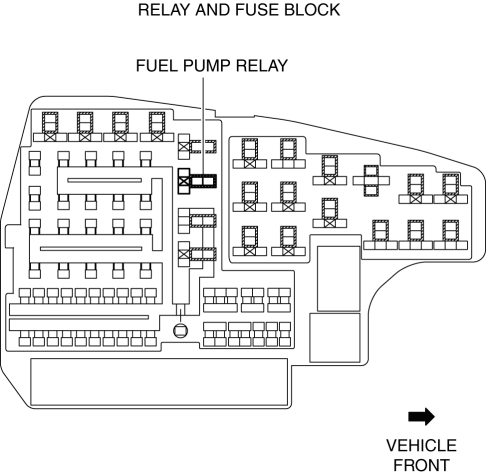Mazda CX-5 Service & Repair Manual: Before Service Precaution
WARNING:
-
Fuel vapor is hazardous. It can very easily ignite, causing serious injury and damage. Always keep sparks and flames away from fuel.
-
Fuel line spills and leakage from the pressurized fuel system are dangerous. Fuel can ignite and cause serious injury or death and damage. Fuel can also irritate skin and eyes. To prevent this, always complete the “Fuel Line Safety Procedure”.
-
A person charged with static electricity could cause a fire or explosion, resulting in death or serious injury. Before performing work on the fuel system, discharge static electricity by touching the vehicle body.
Fuel Line Safety Procedure
1. Disconnect the negative battery cable..
2. Remove the fuel-filler cap to release the pressure inside the fuel tank.
3. Remove the fuel pump relay.

4. Disconnect the high pressure fuel pump connector.
5. Connect the negative battery cable..
6. Start the engine.
7. After the engine stalls, crank the engine 2—3 times.
8. Switch the ignition to off.
9. Disconnect the negative battery cable..
10. Install the fuel pump relay.
11. Connect the high pressure fuel pump connector.
 After Service Precaution
After Service Precaution
WARNING:
Fuel line spills and leakage are dangerous. Fuel can ignite and cause serious
injuries or death and damage. When installing the fuel hose, perform “Fuel Leakage
Inspection” ...
 Check Fuel Cap Warning Light
Check Fuel Cap Warning Light
Purpose/Function
The check fuel cap warning light is built into the instrument cluster.
If the PCM detects that the fuel cap is open, the light illuminates to warn
the driver that th ...
Other materials:
Sunvisors
When you need a sunvisor, lower it for use in front or swing it to the side.
Side Extension Sunvisors
The visor extender extends the sunvisor's range of sun shading.
To use, pull it out.
CAUTION
When moving the sunvisor, retract the visor extender to its original position.
Otherwise, ...
Wheel Alignment Pre Inspection
1. Park the vehicle on level ground, in an unloaded condition*, with the wheels
straight forward.
*: Unloaded condition.....Fuel tank is full. Engine coolant and engine oil are
at specified level. Spare tire, jack and tools are in designated position.
2. Inspect the tire pressure.
...
Crankshaft Pulley
Purpose, Function
The crankshaft pulley transmits the drive force to the auxiliary parts via
the drive belt.
The crankshaft pulley suppresses torsional vibration of the crankshaft.
Construction
The crankshaft pulley is installed to the front of the crankshaft.
...
